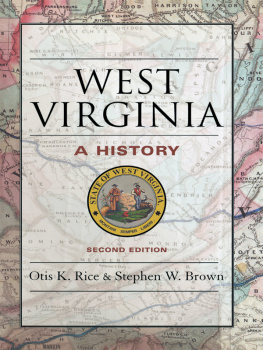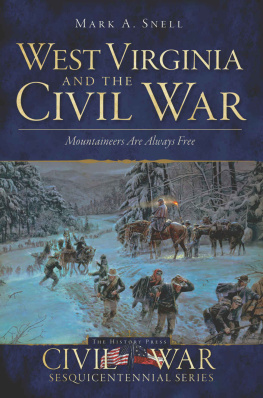West
Virginia
A HISTORY
Otis K. Rice
Stephen W. Brown
Second Edition
THE UNIVERSITY PRESS OF KENTUCKY
This edition was made possible in part by a grant
from the National Endowment for the Humanities.
First edition copyright 1985 by The University Press of Kentucky
Second edition copyright 1993 by The University Press of Kentucky
Scholarly publisher for the Commonwealth, serving Bellarmine University, Berea College, Centre College of Kentucky, Eastern Kentucky University, The Filson Historical Society, Georgetown College, Kentucky Historical Society, Kentucky State University, Morehead State University, Murray State University, Northern Kentucky University, Transylvania University, University of Kentucky, University of Louisville, and Western Kentucky University. All rights reserved.
Editorial and Sales Offices: The University Press of Kentucky
663 South Limestone Street, Lexington, Kentucky 40508-4008
www.kentuckypress.com
13 12 11 10 09 10 9 8 7 6
Library of Congress Cataloging-in-Publication Data
Rice, Otis K.
West Virginia : a history / Otis K. Rice, Stephen W. Brown.
2nd ed.
p. cm.
Includes bibliographical references (p.) and index.
ISBN 0-8131-1854-9 (alk. paper)
1. West VirginiaHistory. I. Brown, Stephen W., 1950
II. Title.
F241.R515 1993
975.4dc20 93-17819
ISBN-13: 978-0-8131-1854-3
This book is printed on acid-free recycled paper meeting
the requirements of the American National Standard
for Permanence in Paper for Printed Library Materials.
Manufactured in the United States of America.
Member of the Association of
American University Presses
For David Neal, Matthew, and Lennie
Preface
The first edition of West Virginia: A History, published in 1985, was designed for informed West Virginians and others interested in the history of the state. The approach was primarily narrative and based upon the belief that most readers desired essential information and a faithful re-creation of the past rather than one predominantly interpretive or analytical.
In this second edition we have retained the same approach, but we have added a chapter on the 1980s and 1990s. We have also updated or amended some material in the text and bibliographical listings. Insofar as possible, we have based this work upon scholarly writings, both past and present, and commented upon their findings and interpretations, while at the same time we have offered our own views when they seemed essential or desirable. Although we subscribe to the belief that history may inform and elucidate the present, we have not attempted to draw out only those threads that seem to exist in the late twentieth century. The past has its own integrity, and recapturing it for its own sake may in the long run be as instructive as winnowings that appear to have special relevance to some later time. We have tried to recognize that integrity without ignoring pertinent threads from the past where they genuinely appear to exist.
In the course of our research, we have relied upon the staffs of numerous libraries, but our greatest dependence has been upon those of the Vining Library of West Virginia Institute of Technology, the West Virginia Division of Archives and History, the Kanawha County Public Library at Charleston, and the West Virginia University Library. They have been unfailingly sympathetic and helpful. The collection and reproduction of photographs have been greatly facilitated by the courtesies of Rodney Pyles, a former director of the West Virginia Division of Archives and History, and his cooperative staff; Rodney Collins, director of the Historical Preservation Unit of the West Virginia Division of Archives and History; Daniel Fowler and Ray Swick of the Blennerhassett Historical Park Commission, Parkersburg; and Professor Raymond Janssen of the Department of Geology of Marshall University. Dr. Kenneth R. Bailey and the West Virginia Institute of Technology Foundation rendered a valuable service by providing funds for preparation of the maps.
We also extend our thanks to Dr. Ken Hechler, West Virginia secretary of state; Dr. Gordon R. Short, vice-president for Academic Affairs, West Virginia Institute of Technology; Kenneth M. Ferguson, Planning and Research Division supervisor, West Virginia Department of Transportation; Sharon Lewis, West Virginia Department of Education; and Sharon Burgess Paxton, research analyst, West Virginia Development Office. Finally, we thank students and other readers for useful comments on the first edition of this work and for encouraging us to undertake a second edition.
1
Prehistorie Times
A Land of Grandeur. In 1784, nearly two hundred years before a popular song referred to West Virginia as almost Heaven, Thomas Jefferson wrote that the contrast between the placid and delightful Shenandoah Valley and the wild and tremendous mountains at Harpers Ferry, the Potomac gateway to the state, was worth a journey across the Atlantic Ocean. Jefferson might have found equally awesome beauty in Hawks Nest, a crag towering 585 feet above the turbulent New River, spectacular waterfalls in the Kanawha, Little Kanawha, and Blackwater rivers, the serenity of the Canaan Valley, and numerous other natural formations in West Virginia.
Geological Determinants. The striking physiography of West Virginia has sprung from geological activity. For some four hundred million years, the state lay in a long trough, or geosyncline, that extended from New Brunswick to Alabama, where the Appalachian Highlands are today. The trough was actually an arm of the ocean, which left vast deposits of salt, either as brine or rock salt, in the western parts of West Virginia and limestone, from fossils of marine animals, in the eastern sections.
To the east of the trough rose a continent known as Old Appalachia. From it and other highlands, material washed down into the geosyncline, pressing it downward and forcing the surrounding rock upward. This action weakened the geosyncline and gave rise to a disturbance known as the Appalachian Revolution, in which rock strata were repeatedly folded and uplifted. Prior to the final upheaval much of West Virginia was swampland with luscious vegetation, which decomposed and formed vast beds of coal. About seventy million years ago the state and surrounding areas were part of a peneplain, worn almost flat by erosion. Uplift, nevertheless, continued, and at the beginning of the Ice Age, about one million years ago, streams and erosion had sculptured the landscape of West Virginia essentially as it is today. Continued action, however, has since deepened the valleys and sharpened the contours of the land.
During the Ice Age, which ended only about ten thousand years ago, great polar ice sheets crept southward into the present Ohio Valley. The glaciers did not reach West Virginia, but they drastically changed its drainage system. Lake Erie did not exist before the Ice Age, and streams from the Allegheny Plateau flowed in a northwesterly direction into the Erie Basin and then into the ancient Saint Lawrence River. The ice blocked the Monongahela River, which followed roughly its present course toward Pittsburgh before turning into the Erie Basin at Beaver Falls, and impounded its waters in the Monongahela Valley to a depth of about eleven hundred feet. The lake thus formed extended southward to the Little Kanawha Valley and overflowed through a channel approximating modern Fishing Creek. Waters of the lake receded with the formation of the Ohio River, which carved its valley as a marginal glacial stream.









